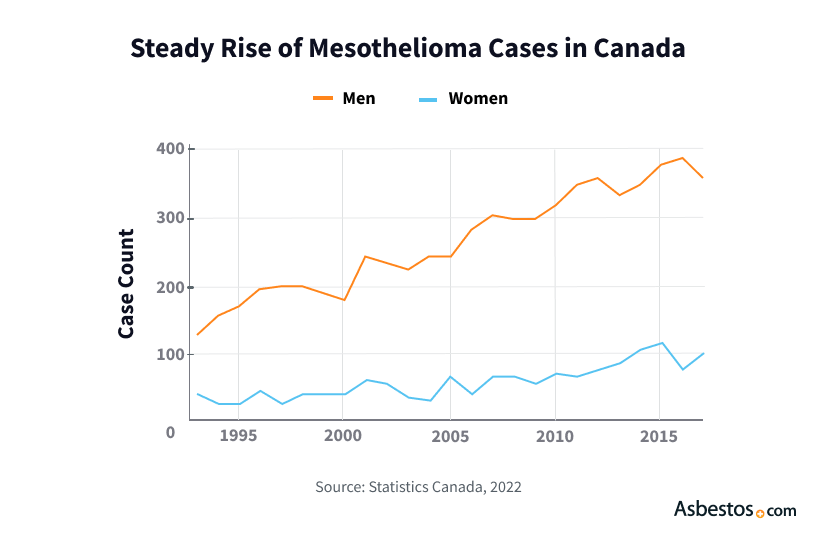Based on Your Reading:
Get Your Free Mesothelioma Guide

Find a Top Mesothelioma Doctor

Access Help Paying for Treatment

Though the Canadian government once supported the industry, the nation banned asbestos in 2018. However, mesothelioma cases continue to rise as workers exposed on the job decades ago begin to show symptoms. In 2022, 472 Canadians died of the asbestos-related disease.

Written by Karen Selby, RN • Edited By Walter Pacheco • Scientifically Reviewed By Arti Shukla, Ph.D.
The Mesothelioma Center at Asbestos.com has provided patients and their loved ones the most updated and reliable information on mesothelioma and asbestos exposure since 2006.
Our team of Patient Advocates includes a medical doctor, a registered nurse, health services administrators, veterans, VA-accredited Claims Agents, an oncology patient navigator and hospice care expert. Their combined expertise means we help any mesothelioma patient or loved one through every step of their cancer journey.
More than 30 contributors, including mesothelioma doctors, survivors, health care professionals and other experts, have peer-reviewed our website and written unique research-driven articles to ensure you get the highest-quality medical and health information.
My family has only the highest compliment for the assistance and support that we received from The Mesothelioma Center. This is a staff of compassionate and knowledgeable individuals who respect what your family is experiencing and who go the extra mile to make an unfortunate diagnosis less stressful. Information and assistance were provided by The Mesothelioma Center at no cost to our family.LashawnMesothelioma patient’s daughter


Selby, K. (2024, April 23). Asbestos and Mesothelioma in Canada. Asbestos.com. Retrieved April 24, 2024, from https://www.asbestos.com/mesothelioma/canada/
Selby, Karen. "Asbestos and Mesothelioma in Canada." Asbestos.com, 23 Apr 2024, https://www.asbestos.com/mesothelioma/canada/.
Selby, Karen. "Asbestos and Mesothelioma in Canada." Asbestos.com. Last modified April 23, 2024. https://www.asbestos.com/mesothelioma/canada/.
Occupational asbestos exposure is an ongoing issue in Canada, even with decreased use of the material. An estimated 235,000 Canadian workers experienced some type of exposure while on the job. Of these workers, 5% have high exposure, 46% have moderate exposure and 49% have low exposure.
Most of these workers are men within the construction industry. In 2019, 460 Canadians received a diagnosis of mesothelioma and in 2022, 472 Canadians died of the disease. Of these, 80% were men.
I wasn’t caught totally off guard with my diagnosis. It just took 48 years before the effects of my asbestos exposure finally showed up.
Direct asbestos use and handling has declined, but the material remains in older buildings. Anyone who spends a lot of time in these aging structures has a higher risk of developing an asbestos-related illness. Legacy asbestos is a big risk factor for mesothelioma cancer.
Additionally, while asbestos mines like Quebec’s Thetford have closed, as have asbestos manufacturing plants, the latency period between exposure and when symptoms present is between 20 to 60 years. Many Canadians continue to receive diagnoses of asbestos-related diseases today.
Though Canada’s asbestos mines closed, Canadian workers are still at risk of exposure across many industries, especially those who spend significant time in older buildings. Asbestos use in building materials was at its height before the 1980s.
More than 20,000 buildings in Canada still contain asbestos. Insulation, roofing shingles, paint and floor and ceiling tiles are some of the biggest categories of asbestos-containing products.
Some of the highest rates of mesothelioma occur in Quebec and Vancouver, where mining and shipyards were major employers. A 2022 study determined that Quebec’s Lake Becancour contains sediment with up to 4.4% asbestos by weight.
Demolition and remodeling of older buildings is often dangerous because it disturbs the asbestos. The material is most hazardous when the fibers get crushed. Asbestos dust becomes airborne, making it easier to breathe in. Breaking any product made with asbestos releases tiny fibers into the air that are a health threat to anyone nearby.
Get Your Free Mesothelioma Guide

Find a Top Mesothelioma Doctor

Access Help Paying for Treatment

Canada officially banned asbestos in 2018 with the Prohibition of Asbestos and Products Containing Asbestos Regulations. However, some industries received an exemption to continue legally using the toxic mineral within stated regulations.
2018
Canada prohibited the import, sale and use of asbestos as well as the manufacture, import, sale and use of asbestos products, with some exclusions.
The military and nuclear energy industries have until 2029 to phase out asbestos use. The deadline is 2030 for the chloralkali industry. Another notable exception is magnesium extraction companies, which can continue to use asbestos mining waste.
The government has also moved toward restricting talc products such as cosmetics. Canada will likely label talc as an official toxic substance because of frequent asbestos contamination. Some Canadians may be able to file lawsuits involving asbestos-contaminated talc.
All Canadian asbestos mines are currently inactive as of the final closures of Quebec’s Jeffrey Mine in Val-des-Sources and the Lac d’amiante du Canada, or Thetford Mine, in 2011. Putting a stop to asbestos production will most likely have a significant impact on the future mesothelioma rate in Canada.
Canada opened its first asbestos mine in 1874 in the province of Quebec. Asbestos was soon considered “Canada’s Gold,” and the country produced 40% of the world’s chrysotile asbestos at one time, with the biggest deposits in British Columbia, Newfoundland, Quebec and Yukon.
The significance of asbestos to Canada inspired one mining town in Quebec to adopt the name “Asbestos” out of pride. However, Health Canada began to study asbestos and its threats to health in early 2008. Asbestos’s mine closed in 2011, and the town renamed itself Val-des-Sources in 2020 to avoid further association with the toxic material.
Despite shutting down the asbestos mining industry, the country’s past industry has continued environmental and socio-economic impacts. Some areas remain covered in asbestos mining residue, with area residents facing health risks. There is high demand for reclamation efforts to restore the ecological health in affected areas.
Most cases of mesothelioma in Canada stem from occupational asbestos exposure. Mesothelioma can develop in the chest or abdomen. The pleural form affects the chest lining and lungs, while the peritoneal type affects the abdominal lining. Common symptoms of mesothelioma include cough, shortness of breath, fatigue and chest pain.
Asbestos fibers easily break down into dust and float through the air. When an individual breathes these particles in, they get trapped within the sensitive tissues of the chest and abdomen, leading to years of irritation.
It can take between 20 and 60 years for this irritation to develop into disease and manifest symptoms. This latency period makes getting an early diagnosis difficult, with many cancers diagnosed only after they develop into later stages.
The Ottawa, Ontario, resident was diagnosed at age 31. It took an expert pathologist who specialized in mesothelioma to identify the cancer. Jayda was most likely exposed to asbestos as a child through her father, who worked in a lab at a coal mine where he used and tested asbestos products. He also did mechanical work with asbestos parts on the machinery.
Despite the ban on asbestos, the annual rate of mesothelioma cases in Canada has jumped from 75 cases in 1993, to 250 in 2017, to 460 diagnosed cases in 2019. The disease’s extended latency period of decades means that new cases will likely continue to emerge for some time.

The rate of this cancer in men aged 60 and under has slightly declined. However, it’s unlikely that the overall mesothelioma rate in Canada will decrease significantly for many years.
Some Canadian residents may be eligible for compensation if their exposure happened on the job as a result of an employer’s negligence. Provincial governments have a system in place to pay patients and families experiencing the impacts of asbestos in Canada. Anyone whose exposure occurred while living or working in the United States can file a claim in the U.S. to seek compensation.
Speak with an experienced attorney specializing in asbestos-related illnesses to determine if your case qualifies you for compensation from a trust fund or lawsuit. You must have proof of your diagnosis and evidence of asbestos exposure. Most eligible people can receive compensation in three to six months.
Mesothelioma patients in Canada have the option to file either a lawsuit or trust fund claim to get financial compensation. Family members who have lost a loved one to mesothelioma can also file a lawsuit to pursue a wrongful death claim.
Patients and families can use the money to help cover the cost of medical bills, lost work and other expenses related to their diagnosis. Eligible residents can pursue additional options for compensation or financial assistance through the Canada Pension Plan, WorkSafeBC disability pension or Veterans Affairs, which offers disability pensions and class action lawsuits.

Canada’s socialized medical model makes treatment options for mesothelioma accessible to many patients. Doctors use a multimodal approach to treat mesothelioma. Surgery, chemotherapy and radiation are frequent methods of treatment. Some patients may also be eligible for clinical trials.
Heated intraperitoneal chemotherapy and cytoreductive surgery have proven safe and effective for some individuals with peritoneal mesothelioma. In patients with pleural mesothelioma, adding pembrolizumab to standard chemo treatments can increase survival rates.
Mesothelioma treatment centers provide a wide range of options to patients. The treatment center that is right for you depends on factors like your cancer stage and tumor size as well as your location. Some centers also take patient age and overall health into consideration.
Top Mesothelioma Treatment Centers in Canada
| CENTER/INSTITUTE | LOCATION |
|---|---|
| Cross Cancer Institute at U of Alberta | Edmonton, Alberta |
| Princess Margaret Cancer Centre | Toronto, Ontario |
| Vancouver Cancer Centre | Vancouver, British Columbia |
| McGill University Health Centre | Montreal, Quebec |
| The Ottawa Hospital Regional Cancer Centre | Ottawa, Ontario |
Speak with your doctor regarding your options for treatment to get recommendations on what is right for you. Discuss your plans with your family as well. It’s important to have a support system to rely on as you focus on your treatment.
You can find a variety of Canadian healthcare providers familiar with asbestos-related diseases, including oncologists, radiologists and surgeons. The number of doctors who specialize in treating mesothelioma continues to increase.
| MESOTHELIOMA DOCTOR | LOCATION |
|---|---|
| Robert MacRae, M.D. | Ottawa, Ontario |
| Christopher Lee, M.D. | Vancouver, British Columbia |
| Rufus Scrimger, M.D. | Edmonton, Alberta |
| Marc de Perrot, M.D. | Toronto, Ontario |
| Walley Temple, M.D. | Calgary, Alberta |
Seek out medical practitioners who have experience and training in treating mesothelioma. Their specialized knowledge and skill sets allow them to provide the best possible care.
Patients may want to consider getting involved in a clinical research trial. The Canadian Cancer Society and the U.S. National Cancer Institute often work together on clinical trials that test the safety and effectiveness of emerging mesothelioma treatments.
One current clinical trial open to eligible candidates is taking place at the Princess Margaret Cancer Centre in Toronto, Ontario. This study is researching the safest effective dose of a new type of radiation after surgery. It ends in 2025.
An excellent source to check for open clinical trials throughout Canada is the Government of Canada website. If you are considering a clinical trial, speak with your doctor about eligibility.
Canada banned asbestos in 2018 with the Prohibition of Asbestos and Products Containing Asbestos Regulations, but left several legal exemptions. The military and nuclear energy industries can use asbestos until 2029, while the chloralkali industry has until 2030 to stop usage. Magnesium extraction companies can continue to produce asbestos mining waste.
While all asbestos mines closed by 2011, many older buildings still pose an exposure risk as they contain materials made with asbestos.
Recent mesothelioma rate statistics show that cases steadily increased over the years, reaching 460 diagnoses in 2019. An estimated five Canadians receive an asbestos-related diagnosis every day.
2022 statistics reported 472 deaths from mesothelioma. 377 of these were men and 95 were women.
The regions in Canada that experienced the most impact from asbestos were those that contained large mineral deposits where workers mined and transported the material. This includes British Columbia, Newfoundland, Quebec and Yukon. Miners, along with truck drivers and ship loaders, had high levels of exposure daily.

Have a question? Contact one of our Patient Advocates and get the answers you need.

Connect, share stories and learn from the experiences of others coping with mesothelioma in one of our support groups.

We help support charities, hospitals and awareness groups working to help people impacted by asbestos and cancer.
Your web browser is no longer supported by Microsoft. Update your browser for more security, speed and compatibility.
If you are looking for mesothelioma support, please contact our Patient Advocates at (855) 404-4592
